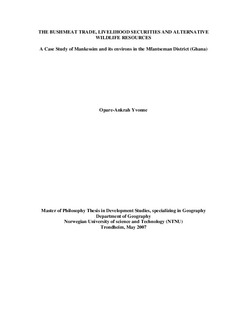| dc.contributor.author | Opare-Ankrah, Yvonne | nb_NO |
| dc.date.accessioned | 2014-12-19T14:25:31Z | |
| dc.date.available | 2014-12-19T14:25:31Z | |
| dc.date.created | 2007-06-18 | nb_NO |
| dc.date.issued | 2007 | nb_NO |
| dc.identifier | 122432 | nb_NO |
| dc.identifier.uri | http://hdl.handle.net/11250/265219 | |
| dc.description.abstract | Extraction and use of fauna resources is a practice carried out in rural communities in most tropical regions and Africa in particular. In Ghana, forest fringe communities have depended on the extraction of bushmeat initially as a major source of protein and in recent times as an important livelihood activity which has become attractive to young people. Bushmeat has become an important trade commodity and the source of income for many rural household. However, studies have shown that bushmeat trading activities has resulted in the local extinction of large mammals due to the unsustainable way these fauna resources are being extracted.
This study sought to ascertain the important contribution the trade in making towards peoples livelihoods and to discuss specific interventions in place to regulate the use of wildlife resources outside protected areas. A case study approach was adopted and Mankessim and Eyisam in the Mfantseman district in the Central region were chosen as the study area. The study population was bushmeat traders, hunters, chopbar operators and consumers of bushmeat. Both qualitative and quantitative techniques were used in collecting and analyzing data of the study. Purposive sampling was used to select five respondents from each of the categories for interviewing as well as key informants. Simple random sampling was used in selecting the consumers.
The concept of livelihood and political ecology were the theoretical approaches adopted in explaining the findings of the research.
The findings indicated that bushmeat trading activities involves a chain of actors composed of hunters, wholesalers and chopbar owners/retailers. This livelihood activity is a major contributor to household incomes of the actors of the trade. Skilled unemployed and under employed youth cease the opportunity of the high demand for bushmeat and the profitability of the trade to engage in bushmeat trading activities. Furthermore, the Wildlife Department recognizing the unsustainable extraction of fauna resources in unprotect areas has put in place rules and regulations to regulate the use of these resources.
The study concludes among other things that, the creation of employment avenues for the youths in the district including the cultivation of wildlife as “crops” will reduce the number of young people entering the trade and also reduce the pressures on animals in the wild. Ineffective implementation of wildlife regulations could also result in unsustainable use of fauna resource. | nb_NO |
| dc.language | eng | nb_NO |
| dc.publisher | Fakultet for samfunnsvitenskap og teknologiledelse | nb_NO |
| dc.subject | Master of Philosophy in Development Studies, specialising in Geography | en_GB |
| dc.title | The bushmeat trade, livelihood securities and alternative wildlife resources: A Case Study of Mankessim and its environs in the Mfantseman District (Ghana) | nb_NO |
| dc.type | Master thesis | nb_NO |
| dc.contributor.department | Norges teknisk-naturvitenskapelige universitet, Fakultet for samfunnsvitenskap og teknologiledelse, Geografisk institutt | nb_NO |
